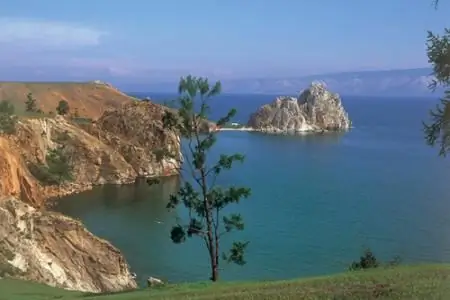- Author Harold Hamphrey [email protected].
- Public 2023-12-17 10:06.
- Last modified 2025-01-24 11:10.
The Hagia Sophia is one of the most beautiful monuments of world architecture. Its history began in 324-327, during the reign of Emperor Constantine. It was then that the first temple was built on the market square, but in 532 it burned down during an uprising. By decree of Emperor Justinian I, a new church was built in the same place as a symbol of the greatness of the empire and the decoration of the capital in the shortest possible time (532-537). For more than ten centuries, Hagia Sophia in Constantinople has been the largest church in the entire Christian world.

And the ambassadors of the Russian Prince Vladimir the Red Sun, having been here, reported to him: the magnificence of this domed basilica of three naves is so great that being in it is akin to being in paradise. Perhaps this is what prompted Vladimir to baptize Russia in the 10th century.
The building of the temple impresses with its size and height, which is 55.6 m. The middle nave is wide, the side ones are narrower. The basilica is crowned with a huge dome, the diameter of which is 31 m. On the Hagia Sophia under construction in the sixth century werecolossal funds were spent - 320 thousand pounds, which amounted to about 130 (!) tons of gold. The columns alone, brought from the legendary Greek and Roman structures, were of great value.

Marble was brought from the Temple of Artemis, granite - originally from the port gymnasium in Ephesus, porphyry delivered to the construction site from the Roman Temple of the Sun and the Sanctuary of Apollo. Marble slabs were mined in ancient quarries, as well as in the bowels of Mount Pentilikon, located 23 km from Athens, famous for the fact that it was from its marble that the Temple of the goddess Athena was built. All the luxury that Hagia Sophia possessed is even hard to imagine, but the fact that gold was melted to make the upper board of the throne for the patriarch, and then precious sapphires, pearls, topazes, amethysts and rubies were specially thrown into it, speaks volumes.
Narthex is a part of the building reserved for preparation for the prayer ritual. You will not see lush decor here - gold and silver coatings disappeared during the Latin invasion. Attention is drawn to the unique mosaic slabs, as well as the columns brought from different places.

Ancient reliefs dating back to the 12th century, mosaic images of Jesus Christ, St. Mary and the Archangel Gabriel, laid out over the imperial door back in the 9th century, instill a special feeling in the soul.
The most talented architects and artists of the time were invited to build the temple. That is why even today the Hagia Sophiaoverwhelms with its significance and beauty. The main space of the church - the naos - has a special lighting created by many windows and arches. Images of Jesus, angels, portraits of the oldest patriarchs, emperors and empresses, giant posters with Arabic writing - all this creates a unique atmosphere.

Here, every centimeter has its own history, ancient manuscripts and a unique library are priceless, and galleries are another marvel of architectural craftsmanship. Huge marble balls, delivered to the temple from Pergamum itself in the 16th century, still adorn the main entrance.
There is one attraction that tourists do not pass by - the Weeping Column. Indeed, according to legend, there is a miraculous hole in it, through which it is enough to draw a finger, draw a circle - and the wish made will come true. Great and beautiful building - Hagia Sophia! Constantinople is a happy city whose heart beats within the walls of this majestic temple.






